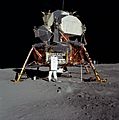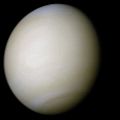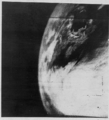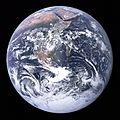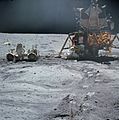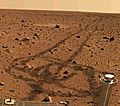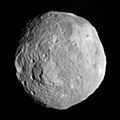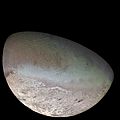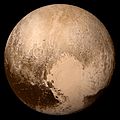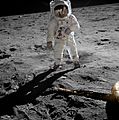Space exploration facts for kids

Space exploration is all about exploring outer space. It means sending people and robots into space to learn more about the Universe. For hundreds of years, people have dreamed of traveling beyond Earth. Thanks to better rockets, this dream came true in the 20th century.
On October 4, 1957, the former Soviet Union launched Sputnik I. This was the first artificial satellite to orbit Earth! It kicked off the "Space Race" between countries. Soon, people were traveling into orbit, and American astronauts even visited the Moon during the Apollo program. Since then, many space probes have traveled to different planets and other places in our solar system. They send back amazing information and pictures.
Contents
Why Do We Explore Space?
People explore space for many reasons. The main goals are:
- Scientific Research: Scientists want to understand how the Universe works. They study planets, stars, and galaxies to learn about their origins and how they change.
- Curiosity: Humans are naturally curious! We want to know what's out there beyond our home planet.
- New Technologies: Space exploration pushes us to invent new tools and technologies. These inventions often help us here on Earth too, like better weather forecasts or GPS.
- Finding Resources: Some people believe we might find valuable materials on other planets or asteroids in the future.
- Protecting Earth: By understanding space, we can learn more about things that might affect Earth, like asteroids.
Early Steps into Space
Getting into space was a huge challenge! It needed powerful rockets and brave pioneers.
The First Satellite
The launch of Sputnik 1 in 1957 was a major moment. It was a small, shiny ball that beeped as it circled Earth. This showed that humans could send objects into space.
First Humans in Space
After Sputnik, the next big step was sending a person into space.
- On April 12, 1961, Yuri Gagarin from the Soviet Union became the first human in space. He orbited Earth once in his Vostok 1 capsule.
- Soon after, on May 5, 1961, Alan Shepard became the first American in space.
Reaching the Moon
The "Space Race" led to an incredible goal: landing humans on the Moon.
- The Apollo program was NASA's plan to do this.
- On July 20, 1969, Apollo 11 landed on the Moon. Astronauts Neil Armstrong and Buzz Aldrin were the first people to walk on another celestial body. This was a huge achievement for humanity!
Exploring Our Solar System
Since the Moon landings, robots have been sent to explore almost every planet in our Solar System.
Visiting Nearby Planets
- Mars: Many space probes and rovers have landed on Mars. They search for signs of past water and life. Rovers like Curiosity and Perseverance have sent back amazing pictures and data from the Martian surface.
- Venus: This planet is very hot and has a thick atmosphere. Probes have flown by and even landed on Venus, but the conditions are too harsh for long stays.
Exploring Gas Giants
- Jupiter and Saturn: Spacecraft like Voyager 1, Voyager 2, and Cassini have visited these giant planets. They've shown us incredible storms on Jupiter and the beautiful rings of Saturn up close. Cassini even explored Saturn's moon Titan, which has lakes of liquid methane!
- Uranus and Neptune: Only Voyager 2 has flown past these distant ice giants. It sent back the first close-up images of these mysterious worlds and their moons.
Beyond the Planets
- Dwarf Planets and Asteroids: Missions like New Horizons flew past Pluto in 2015, giving us our first clear look at this distant dwarf planet. Other spacecraft have visited asteroids and comets, learning about the building blocks of our solar system.
The Future of Space Exploration
Space exploration is still going strong!
- Return to the Moon: Programs like Artemis plan to send humans back to the Moon. This time, they aim to stay longer and build bases.
- Human Missions to Mars: Scientists and engineers are working on sending humans to Mars in the future. This would be a huge challenge, but it's a major goal.
- Searching for Life: Spacecraft continue to search for signs of life, especially on places like Mars and moons of Jupiter and Saturn that might have oceans under their icy surfaces.
- Exploring Beyond Our Solar System: While very difficult, scientists are thinking about ways to send probes to other star systems in the far future.
Space exploration helps us understand our place in the vast Universe and inspires us to keep learning and discovering.
Images for kids
-
Buzz Aldrin and Apollo 11's lunar lander on the Moon's surface
-
Self-portrait of Curiosity rover on Mars's surface
-
V-2 Rocket in the Peenemünde Museum
-
Sputnik 1, the first artificial satellite orbited Earth at 939 to 215 km (583 to 134 mi) in 1957, and was soon followed by Sputnik 2. See First satellite by country (Replica Pictured)
-
The Moon as seen in a digitally processed image from data collected during the 1992 Galileo spacecraft flyby
-
Mariner 10 image of Venus (1974)
-
The Blue Marble Earth picture taken during Apollo 17 (1972)
-
Apollo 16 LEM Orion, the Lunar Roving Vehicle and astronaut John Young (1972)
-
Mars, as seen by the Hubble Space Telescope (2003)
-
Surface of Mars by the Spirit rover (2004)
-
Asteroid 4 Vesta, imaged by the Dawn spacecraft (2011)
-
Jupiter, as seen by the Hubble Space Telescope (2019).
-
A picture of Saturn taken by Cassini (2004)
-
A view beneath the clouds of Titan, as seen in false colour, created from a mosaic of images taken by Cassini (2013)
-
New Horizons image of Pluto (2015)
-
New Horizons image of Charon (2015)
-
This high-resolution image of the Hubble Ultra Deep Field includes galaxies of various ages, sizes, shapes, and colors. The smallest, reddest galaxies, are some of the most distant galaxies to have been imaged by an optical telescope.
-
The United States' planned Space Launch System concept art
-
Astronaut Buzz Aldrin had a personal Communion service when he first arrived on the surface of the Moon.
Related articles
See also
 In Spanish: Exploración espacial para niños
In Spanish: Exploración espacial para niños



